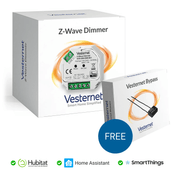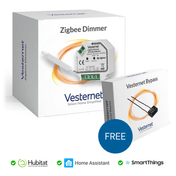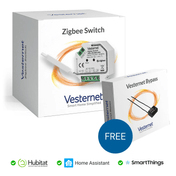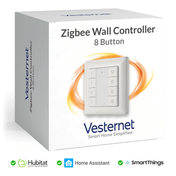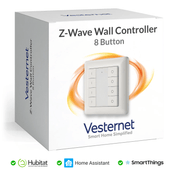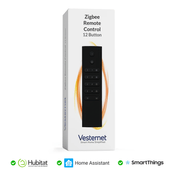Modern homeowners increasingly recognise that comprehensive home security extends far beyond traditional burglar alarm window sensors. Today's smart homes demand sophisticated monitoring solutions that address break-ins, energy efficiency concerns, and family safety through reliable detection technology. Whether you're seeking an alarm system window sensor for basic security or the best door window sensor with advanced features, the choice significantly impacts your home's protection and automation capabilities.
This detailed comparison examines two leading security system window sensors: the Aeotec Door/Window Sensor 7 Pro with its revolutionary tilt detection technology, and the Fibaro Universal Sensor 2 featuring integrated temperature monitoring. Each offers distinct advantages for different smart home scenarios, from advanced automation enthusiasts to homeowners seeking straightforward security solutions.
At Vesternet, our years of experience helping UK customers navigate Z-Wave technology ensures you receive expert guidance tailored to your specific requirements. Our comprehensive understanding of smart home ecosystems enables us to recommend solutions that truly match your security needs and technical comfort level.

Aeotec Door/Window Sensor 7 Pro: Advanced Tilt Detection Technology
The Aeotec Door/Window Sensor 7 Pro represents a significant advancement in window monitoring technology, moving beyond basic open/closed detection to include sophisticated tilt sensing capabilities. This innovative approach detects when windows are opened, closed, or positioned at tilt angles of at least 5 degrees, providing comprehensive monitoring that traditional contact sensors simply cannot match.
Key Technical Features
- Advanced tilt detection with 5-degree sensitivity threshold
- Potential-free input for connecting additional binary sensors
- Replaceable core design for long-term reliability
- Scene control capabilities through momentary switch connections
- Slim profile for discreet installation on window casements
The sensor's expandability sets it apart from conventional security system window sensors. Its potential-free input allows connection of NTC contacts, micro switches, or flood sensors, effectively transforming a single device into a comprehensive monitoring hub. This modularity makes it an excellent choice for tech-savvy homeowners seeking maximum functionality from their alarm system window sensor investments.

Fibaro Universal Sensor 2: Integrated Temperature and Security Monitoring
Fibaro's approach combines traditional magnetic contact detection with built-in temperature sensing, creating a dual-function device that serves both security and environmental monitoring needs. This integration eliminates the need for separate sensors whilst maintaining the reliability expected from professional security system window sensors.
The device's wireless Z-Wave Plus compatibility ensures seamless integration with existing smart home networks. Its battery-powered operation requires no hardwiring, whilst the double tamper protection provides additional security against unauthorised removal or tampering attempts.
Integrated Functionality Benefits
- Magnetic contact detection for door and window monitoring
- Built-in temperature sensor for climate control integration
- Double tamper protection with immediate alert capabilities
- Wireless software updates for ongoing feature enhancements
Installation Methods and Design Approaches: Permanent vs Flexible Mounting
Installation requirements differ significantly between these sensors, reflecting their distinct design philosophies. The Aeotec Door/Window Sensor 7 Pro requires mounting on the window casement with a corresponding magnet positioned on the window frame. This permanent installation approach ensures optimal tilt detection accuracy but may require more careful planning during initial setup.
Aeotec Installation Considerations
- Permanent mounting on window casement for stability
- Precise magnet positioning crucial for reliable operation
- Replaceable core allows upgrades without sensor removal
- Slim profile minimises visual impact on window aesthetics
The Fibaro Universal Sensor 2 adopts a more flexible approach, utilising double-sided adhesive tape for installation anywhere within the home. This wireless mounting system accommodates various surfaces and interior design requirements without permanent modifications.
Fibaro Installation Advantages
- Adhesive tape mounting requires no tools or permanent changes
- Flexible positioning accommodates diverse architectural styles
- Easy relocation supports changing home automation needs
- Minimal visual impact blends seamlessly with interior design
For rental properties or situations requiring frequent reconfiguration, the Fibaro's installation flexibility proves invaluable. However, the Aeotec's permanent mounting provides superior stability for high-traffic windows or demanding commercial applications.
Both sensors integrate effectively with existing Z-Wave networks, though installation complexity varies based on your technical comfort level and specific mounting requirements. Consider your long-term automation goals when evaluating installation approaches, as permanent mounting may offer better performance reliability whilst flexible installation supports evolving smart home configurations.
Detection Accuracy and Smart Home Integration Performance
Real-world performance distinguishes exceptional security system window sensors from basic alternatives. The Aeotec Door/Window Sensor 7 Pro's tilt detection capability provides granular monitoring that traditional open/closed sensors cannot achieve, detecting partial window positions that might indicate attempted break-ins or energy efficiency concerns.
Performance Metrics Comparison
- Response time: Both sensors deliver sub-second detection alerts
- Battery life: Extended operation with low-power Z-Wave communication
- Network reliability: Z-Wave Plus ensures robust mesh connectivity
- False positive rates: Minimal interference from environmental factors

Integration capabilities significantly impact long-term satisfaction with any alarm system window sensor. The Aeotec's potential-free input enables complex automation scenarios, allowing homeowners to create sophisticated security and environmental monitoring systems. Meanwhile, the Fibaro's integrated temperature sensing provides immediate value for climate control automation without additional sensor purchases.
Z-Wave network reliability proves crucial for both sensors, with mesh networking ensuring consistent communication even in challenging RF environments. Both devices support secure encryption protocols, protecting against wireless security vulnerabilities that plague lesser burglar alarm window sensors. Regular firmware updates maintain optimal performance and security standards throughout the sensor's operational lifetime.
Aeotec Sensor 7 Pro: Strengths and Limitations for Advanced Users
Advanced users particularly appreciate the Aeotec Door/Window Sensor 7 Pro's expandability and sophisticated detection capabilities. Its tilt sensing functionality opens automation possibilities unavailable with traditional contact sensors, enabling nuanced responses based on window positioning rather than simple binary states.
Key Advantages for Power Users
- Revolutionary tilt detection enables advanced automation scenarios
- Potential-free input connects multiple sensor types through single device
- Replaceable core design ensures long-term investment protection
- Scene control capabilities through connected momentary switches
However, this sophistication introduces complexity that may overwhelm users seeking straightforward security monitoring. The permanent installation requirement and precise magnet positioning demand careful planning, whilst the expanded functionality requires deeper Z-Wave network knowledge to maximise benefits. These considerations make it ideal for technically proficient homeowners but potentially challenging for smart home beginners seeking the best door window sensor for basic security needs.
Fibaro Sensor 2: Benefits and Drawbacks for Mainstream Users
The Fibaro Universal Sensor 2 excels in delivering comprehensive functionality through an approachable interface. Its dual-function design combining contact and temperature sensing provides immediate value without complex configuration, making it an excellent choice for homeowners seeking reliable burglar alarm window sensors with additional environmental monitoring capabilities.
Installation simplicity particularly appeals to mainstream users. The adhesive mounting system requires no tools or permanent modifications, whilst the intuitive setup process integrates seamlessly with existing Fibaro or compatible Z-Wave systems. Tamper protection and immediate smartphone notifications provide peace of mind without requiring extensive technical knowledge.
Limitations to Consider
- Basic open/closed detection lacks advanced positioning awareness
- No expandability for connecting additional sensor types
- Adhesive mounting may prove less secure than permanent installation
Matching Sensors to Your Smart Home Setup and Lifestyle Needs
Selecting the optimal security system window sensors requires honest assessment of your technical comfort level, automation goals, and specific monitoring requirements. Tech-savvy homeowners with existing automation systems benefit most from the Aeotec Door/Window Sensor 7 Pro's advanced capabilities, whilst those seeking reliable, straightforward monitoring may prefer the Fibaro Universal Sensor 2's integrated approach.
Ideal Aeotec Users
- Automation enthusiasts seeking maximum customisation flexibility
- Homeowners with complex security requirements beyond basic monitoring
- Properties with tilt-and-turn windows requiring position awareness
- Users planning to connect additional sensors through single devices
Home type significantly influences sensor selection. Period properties with original window fittings may benefit from the Aeotec's permanent mounting stability, whilst modern homes with frequent reconfigurations suit the Fibaro's flexible installation approach. Consider your existing smart home ecosystem when evaluating compatibility and integration requirements.
Ideal Fibaro Users
- First-time smart home adopters seeking plug-and-play solutions
- Homeowners requiring both security and temperature monitoring
- Rental properties or situations requiring non-permanent installation
- Users prioritising interior design integration over advanced functionality
Long-term expandability deserves careful consideration. The Aeotec's modular approach supports growing automation needs, whilst the Fibaro provides complete functionality from installation day. Budget considerations should encompass not just initial sensor costs but potential future expansion requirements and ongoing maintenance needs.
Professional installation requirements vary between sensors. The Aeotec may benefit from professional mounting for optimal performance, whilst the Fibaro's simplicity enables confident DIY installation. Factor installation costs and complexity into your overall decision-making process, particularly for multiple-sensor deployments across larger properties.
Making Your Smart Home Security Decision: Features That Matter Most
Your choice between these exceptional alarm system window sensors ultimately depends on balancing advanced functionality against simplicity and immediate usability. The Aeotec Door/Window Sensor 7 Pro delivers cutting-edge tilt detection and expandability for users seeking the best door window sensor with maximum automation potential, whilst the Fibaro Universal Sensor 2 provides comprehensive security and environmental monitoring through an accessible, integrated solution.

Decision Framework
- Prioritise tilt detection if window positioning monitoring is crucial
- Choose integrated temperature sensing for climate control automation
- Consider installation permanence requirements and mounting flexibility
- Evaluate long-term expandability needs versus immediate functionality
Both sensors represent excellent investments in home security and automation, with distinct advantages serving different user profiles and requirements. Whether you're building a sophisticated smart home ecosystem or seeking reliable monitoring with minimal complexity, these security system window sensors offer proven performance and long-term value.
We encourage you to explore both options in detail, considering how their unique features align with your specific security needs and smart home aspirations. Visit our product pages to discover complete specifications and determine which Aeotec sensor or Fibaro sensor best matches your home automation journey.










